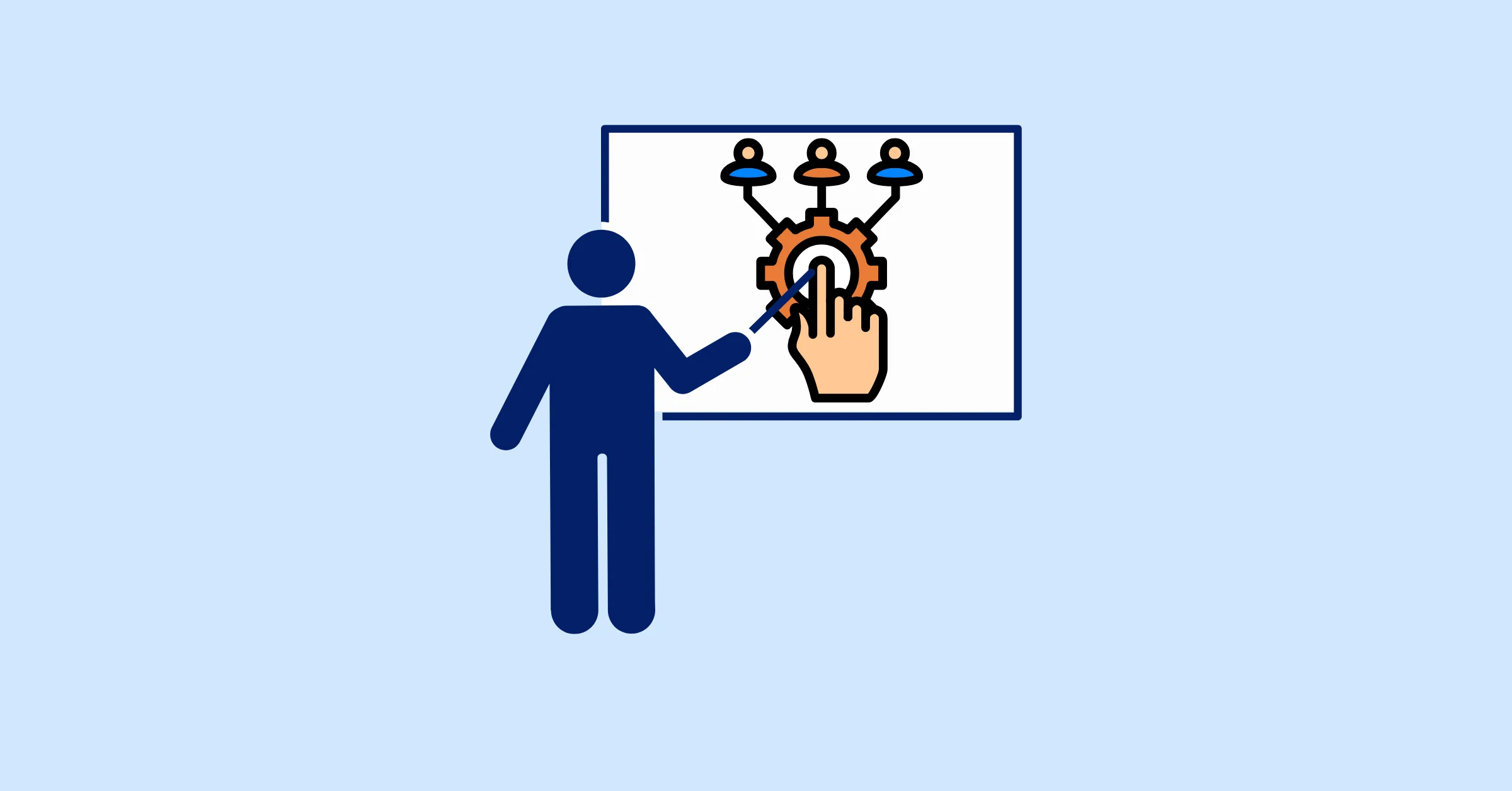What Are Some Common Team Resources That HR Managers Overlook?
What are some common team resources HR overlooks? Learn to activate EAPs, data, and more for engagement and workforce optimization.
HR managers juggle payroll, benefits, compliance, and employee engagement, often missing powerful resources already at their fingertips. These overlooked tools can boost retention, enhance engagement, streamline workload management, and cut costs. Neglecting them risks turnover, disengagement, and wasted budgets, hurting team morale and the bottom line. This article explores why resources get overlooked, their costs, five key examples with strategies to leverage them, and team management tips to identify and activate these assets for workforce optimization.
Why Resources Get Overlooked in the First Place
HR managers face relentless demands, leaving little time to explore existing tools. Several factors contribute to this oversight:
- Limited Awareness: Managers may not know about programs inherited from past leadership or buried in complex systems, especially in large organizations.
- Siloed Departments: Resources often stay confined to one team, with no visibility across departments, hindering collaboration and efficiency.
- Under-Promotion: Tools like employee assistance programs or recognition platforms are rarely highlighted, fading into obscurity among employees.
- Time Constraints: Packed schedules leave HR teams with no bandwidth to audit resources or train staff on their use.
Psychologically, many assume impactful resources must be new or costly, dismissing in-house tools as less valuable. This mindset creates blind spots, causing underuse of assets that could optimize workforce optimization. Recognizing these barriers is the first step to smarter resource management and uncovering hidden value.
The Cost of Overlooking Resources
Neglecting resources has serious consequences for budgets and team dynamics:
- Direct Costs: Underused tools like EAPs or software licenses waste budgets. For instance, an EAP with minimal uptake still incurs full costs, draining funds that could support other initiatives.
- Indirect Costs: The ripple effects are worse—burnout, absenteeism, and turnover. Employees who don’t access support tools may struggle, while unrecognized staff feel undervalued, weakening team cohesion and productivity.
These losses erode performance and financial health. When employees feel unsupported, morale drops, leading to reduced output and higher recruitment costs. Effective resource allocation can reverse these trends, turning overlooked tools into assets that promote teamwork and engagement.
Common Overlooked Resources
Many resources sit dormant despite their potential to transform teams. Below are five commonly overlooked resources, each with a detailed exploration of their value, why they’re missed, and actionable strategies for team productivity and workforce optimization. Follow these team management tips and you'll know what shouldn't be ignored.
Employee Assistance Programs (EAPs)
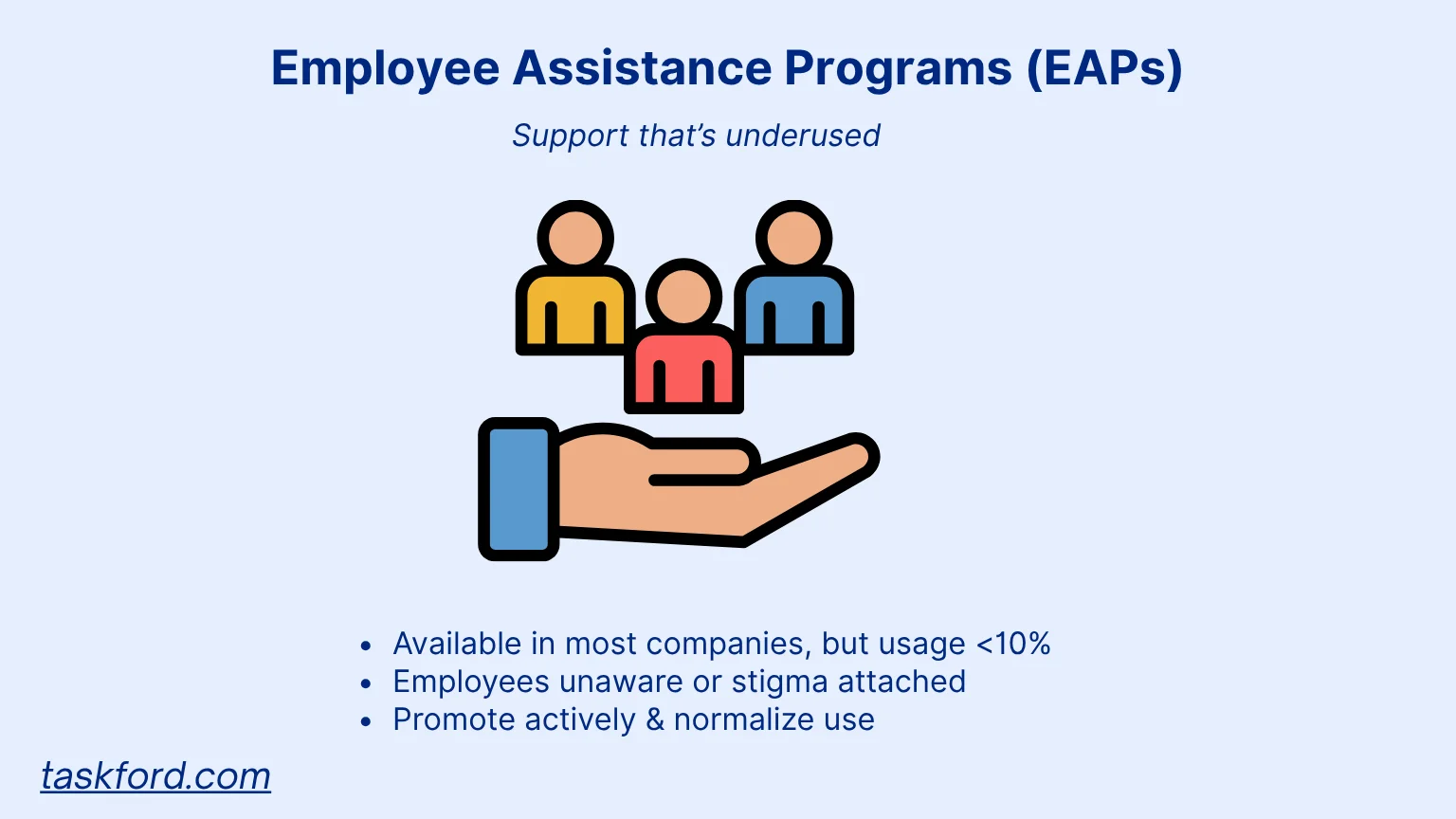
Employee Assistance Program (EAP) offer confidential support for mental health, financial planning, legal advice, and work-life balance. They provide employees with tools to manage stress, debt, or family challenges, ensuring they stay focused and productive.
- Why Overlooked: Poor communication leaves employees unaware of EAPs. Stigma around mental health can deter usage, as employees fear judgment. HR often buries EAP details in onboarding materials or intranet pages, failing to promote them consistently.
- Impact: Underuse means employees miss support that could reduce stress and improve focus. This leads to higher absenteeism, lower productivity, and increased turnover as personal challenges escalate, disrupting team member roles.
- Activation Strategies:
- Share anonymized success stories in newsletters or meetings, like how an employee used EAP counseling to balance work and family.
- Promote through multiple channels: emails, break room posters, or short videos explaining benefits.
- Train managers to discuss EAPs openly, emphasizing confidentiality to reduce stigma.
- Include EAP reminders in regular team check-ins to keep them visible.
- Example: A tech firm launched a monthly EAP spotlight in meetings, sharing how employees used financial counseling to manage debt, significantly reducing stress-related absences.
Employee Data
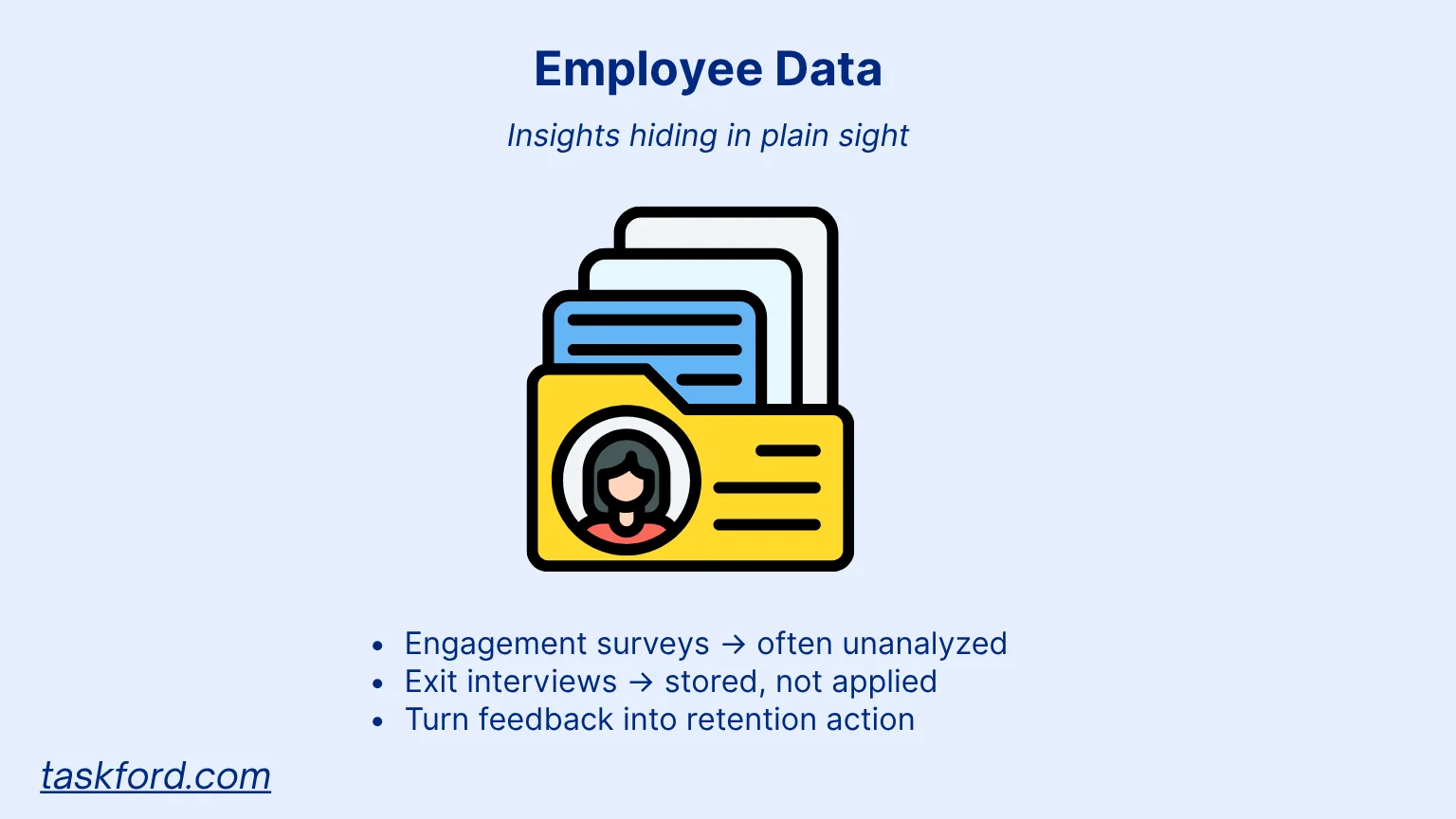
Surveys, exit interviews, and performance reviews collect insights into engagement, satisfaction, and pain points. This data reveals what drives retention, where morale slips, and which resources are underused, guiding strategic resource management.
- Why Overlooked: Data is often collected but left unanalyzed, sitting in HR systems. Managers may lack time or expertise to interpret it, prioritizing urgent tasks over long-term insights, assuming analysis is too complex.
- Impact: Ignoring data misses opportunities to address issues like lack of recognition or poor onboarding. For example, exit interviews might reveal turnover due to unclear team member roles, but without review, the issue persists, costing talent.
- Activation Strategies:
- Schedule quarterly data reviews to identify trends, such as demand for flexible work or training needs.
- Use simple tools like spreadsheets or project management tools to summarize findings and share with leadership.
- Act on insights by promoting existing resources, like highlighting a training platform for skill gaps.
- Share how feedback shapes policies to build employee trust.
- Example: A retail company reviewed survey data showing new hires felt unprepared, prompting HR to promote an existing onboarding platform, improving retention significantly.
Recognition Platforms
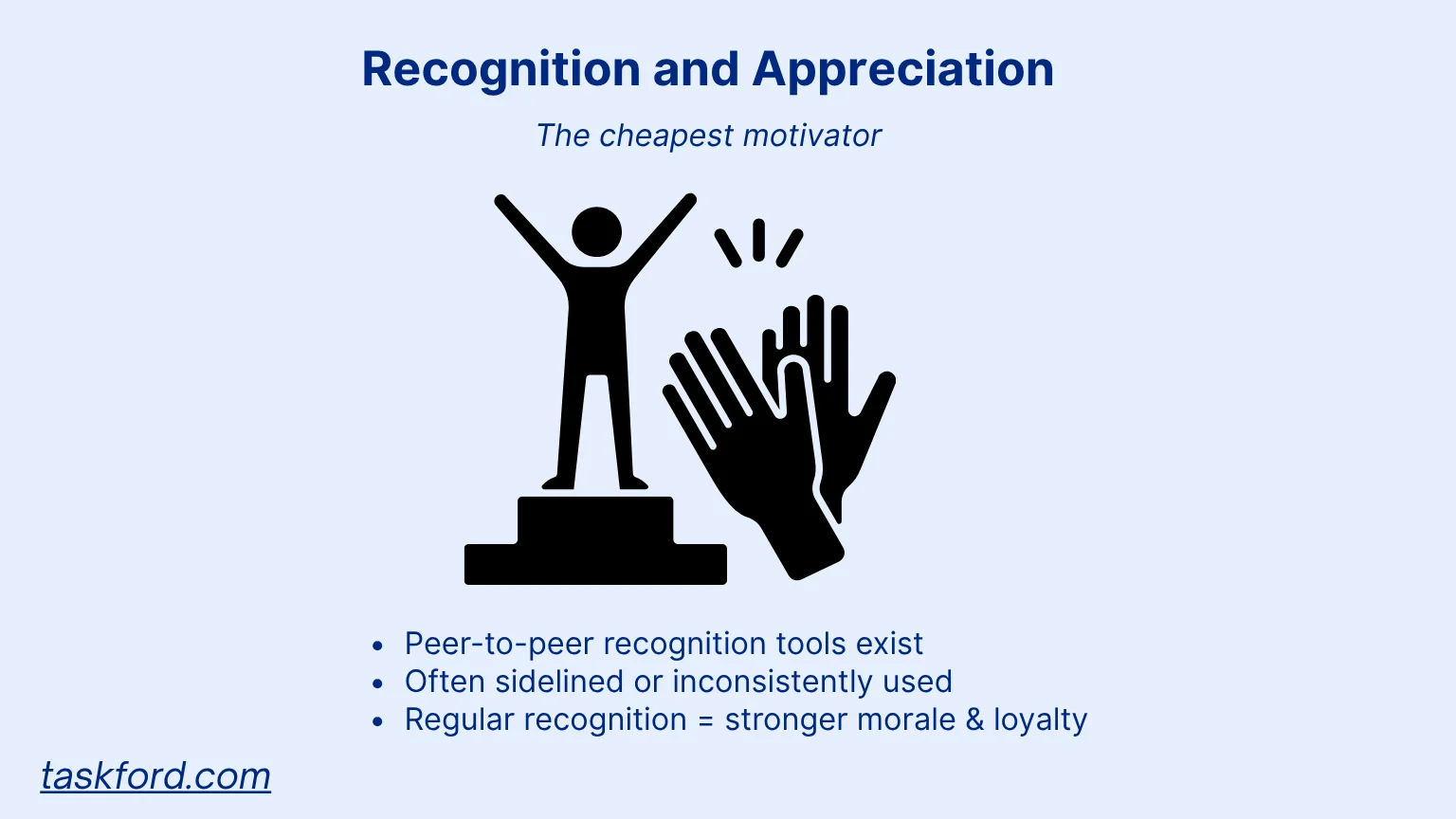
These digital tools enable peer-to-peer and manager-to-employee praise, fostering a culture of appreciation. Features like public leaderboards or private thank-yous boost morale and promote teamwork across departments.
- Why Overlooked: Lack of promotion leaves employees unaware of the platform. Managers may see it as extra work, and without leadership buy-in, adoption stalls. Unintuitive interfaces can also discourage use.
- Impact: Without recognition, employees feel undervalued, leading to disengagement and turnover. Teams miss a simple way to build camaraderie, weakening team productivity and morale.
- Activation Strategies:
- Integrate recognition into team meetings, encouraging managers to give weekly shout-outs.
- Gamify platforms with points or small rewards to spark engagement.
- Offer quick training sessions to show employees how to use the platform easily.
- Highlight top recognizers in company updates to reinforce a culture of appreciation.
- Example: A marketing agency introduced “Recognition Monday” in meetings, leading to a noticeable boost in team morale and collaboration.
Internal Skills and Knowledge
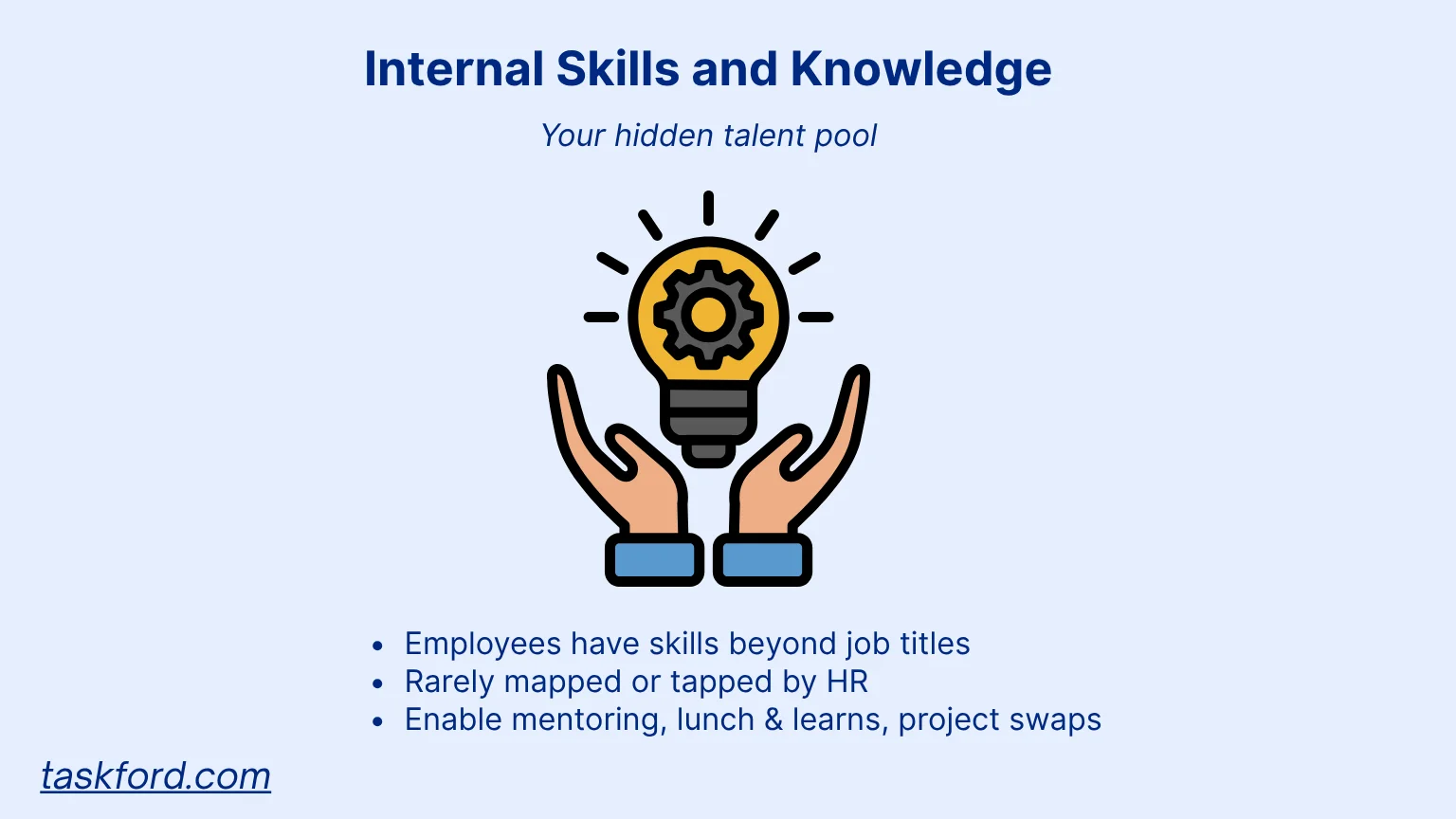
Employees often have untapped expertise like coding, project management, or leadership skills that can address needs without external hires. These skills can fill gaps in projects, training, or innovation, enhancing workforce optimization.
- Why Overlooked: HR prioritizes external solutions, assuming consultants are more qualified. Without a system to track skills, expertise remains hidden, as employees may not volunteer it without prompting.
- Impact: Overlooking talent increases costs for external hires and misses opportunities to engage employees. Staff feel undervalued when skills aren’t used, reducing satisfaction and retention.
- Activation Strategies:
- Conduct skills audits through surveys or one-on-one interviews to catalog expertise.
- Create a talent database to match skills to projects or roles.
- Offer internal gigs or stretch assignments to leverage skills, boosting engagement.
- Recognize employees who contribute skills, reinforcing their value.
- Example: A manufacturing firm identified an employee with project management skills, who led a new initiative, saving significant consultant fees.
Cross-Department Collaboration
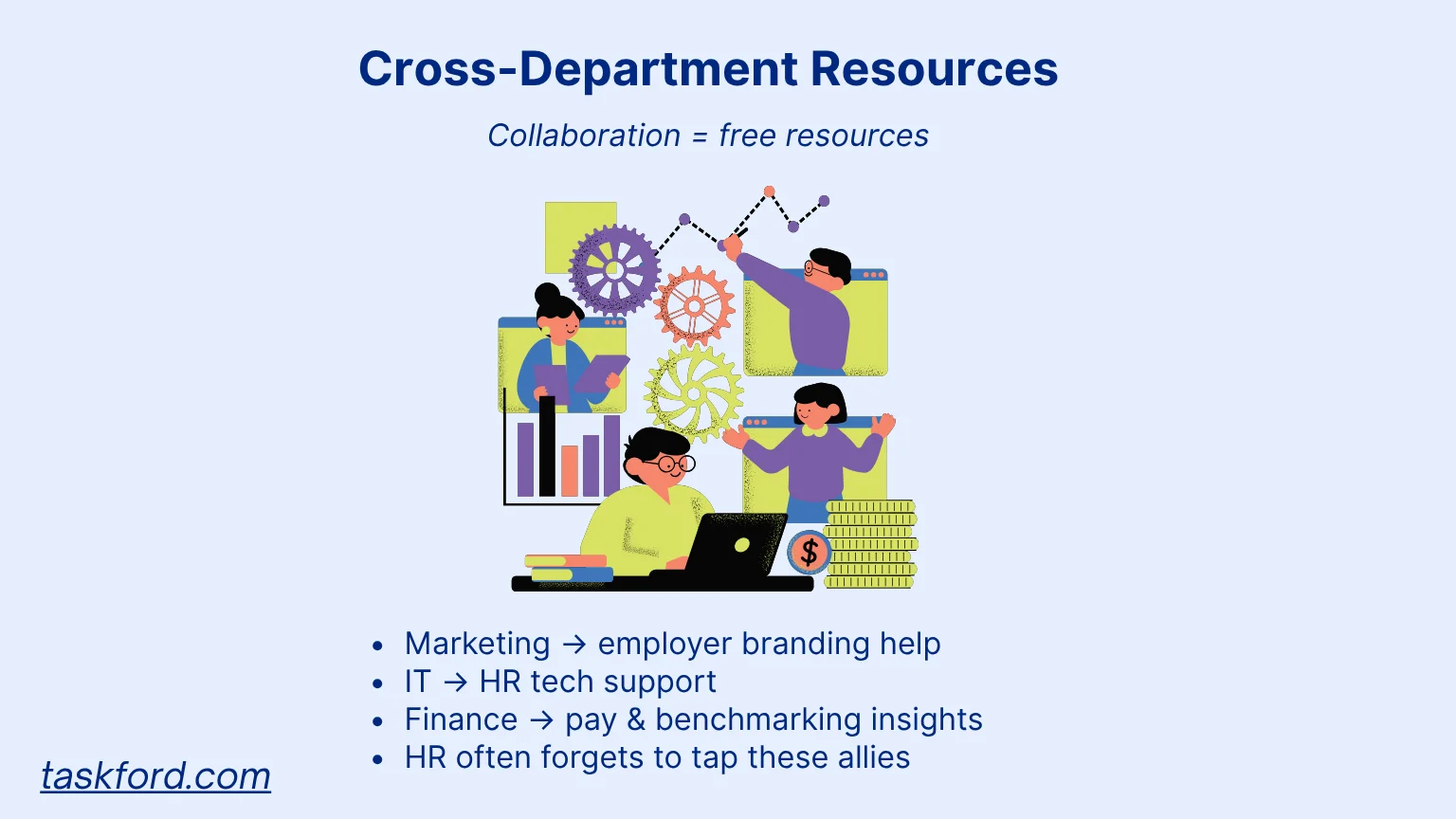
Sharing resources, tools, or knowledge across departments fosters innovation and efficiency. For example, a marketing team’s analytics tool could optimize sales campaigns, or IT’s expertise could streamline HR processes.
- Why Overlooked: Siloed departments limit resource visibility. Without communication channels, teams don’t know what others have, leading to duplication or underuse. Managers may resist sharing, fearing loss of control.
- Impact: This wastes potential and stifles collaboration, reducing efficiency. Teams miss opportunities to leverage tools, like a sales team unaware of a marketing tool that could improve campaigns.
- Activation Strategies:
- Host monthly cross-departmental meetings to share resources and ideas.
- Create a shared digital hub for tool access, ensuring visibility across teams.
- Encourage joint projects to spark collaboration and uncover resources.
- Reward teams that collaborate effectively, reinforcing the behavior.
- Example: A company enabled its sales team to use marketing’s analytics tool, improving campaign targeting and boosting results.
How to Identify Overlooked Resources in Your Organization
Uncovering hidden resources requires a structured approach to resource allocation:
- Audit Tools: Catalog all programs, subscriptions, and resources (e.g., EAPs, software) using a spreadsheet or a tool like TaskFord for clarity.
- Analyze Usage: Review metrics to spot low engagement, like minimal use of a recognition platform, indicating under-promotion.
- Gather Feedback: Survey employees on tool awareness and barriers to identify gaps in communication or access.
- Align with Goals: Map resources to priorities like retention or team productivity to prioritize activation efforts.
This process helps HR pinpoint overlooked resources and create a roadmap for action.
How to Re-Introduce and Activate Underused Resources
To bring resources back to life:
- Launch Campaigns: Promote tools through emails, town halls, or success stories, like how an EAP supported work-life balance.
- Get Manager Buy-In: Train managers to advocate for tools in meetings, such as modeling recognition platform use.
- Simplify Access: Create a centralized HR hub or single sign-on to reduce friction for employees.
- Track Progress: Monitor usage post-campaign and adjust based on feedback to ensure effectiveness.
These steps make resources visible, accessible, and impactful for team member roles.
The Manager’s Role in Unlocking Team Resources
Managers bridge the gap between resources and employees by:
- Modeling Usage: Using tools like recognition platforms or discussing EAP benefits to set an example.
- Allocating Time: Dedicating meeting time for coaching or resource discussions to encourage adoption.
- Linking to Goals: Tying resource use to performance, like using EAPs to reduce stress and boost team productivity.
Their advocacy embeds resources into team culture, driving engagement and promoting teamwork.
Future-Proofing: Avoiding Overlooked Resources Going Forward
To prevent future oversights in resource management:
- Build Awareness: Share monthly tool updates via newsletters, Slack, or briefings to keep resources visible.
- Conduct Audits: Assess usage and relevance annually to retire outdated tools and promote effective ones.
- Adapt to Needs: Use surveys or one-on-ones to align resources with evolving employee demands.
- Use Resource Planning Software: Track workload and capacity to ensure employees and teams aren't overloaded, leading to burnouts.
This approach ensures resources remain valuable and aligned with workforce optimization goals, making workload management easy to handle without significant blockers.
Conclusion
Overlooked resources like EAPs, employee data, recognition platforms, internal skills, and cross-department collaboration are powerful tools waiting to transform teams. Ignoring them wastes budgets and risks turnover, burnout, and disengagement. By auditing, promoting, and activating these assets with team management tips and strategic resource allocation, HR managers can boost engagement and efficiency without extra costs.
It's your challenge to identify one underused resource today and create a plan to activate it. Unlock the potential of what’s already yours for a stronger, more connected workforce.
Learn more
- Resource Management Explained: Key Definition, Must-Know Terms & Proven Techniques
- What Are Three Different Ways to Allocate Resources (and When to Use Each)?
- What Is Resource Planning? Definition, Examples and How to Do it Right?
Making work simpler,
smarter, and more connected
Join our waitlist and be notified first.

Related Blog
Subscribe for Expert Tips
Unlock expert insights and stay ahead with TaskFord. Sign up now to receive valuable tips, strategies, and updates directly in your inbox.






